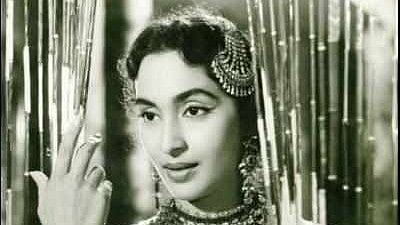
Was there an actress more enchanting and engaging than Nutan? One thing is for sure: Nutan was unlike any other screen legend. She wasn’t a conventional beauty like Madhubala, nor as sprightly and spontaneous as Geeta Bali, nor as graceful and rhythmic as Vyjayanthimala.
And yet, there was something about Nutan. Something deep and knowledgeable, as though she had unearthed the secret of the universe and couldn’t live with the burden of the knowledge.
Born in 1931, Nutan Samarth was introduced to the screen by her mother, the legendary-in-her-own-right Shobhana Samarth, in a film aptly entitled Hamari Beti. Earlier, stalwarts like Chandulal Shah and K. Asif had offered her roles, but the doting mama took it upon herself to launch her beti. Ironically, Nutan fell out with her mother over property disputes. The two women didn’t speak to each other for nearly two decades.

Nutan was a fascinating mixture of steel and satin. Her persona could convey unlimited reserves of fragility and strength in her most celebrated roles, namely Sone Ki Chidiya (where she played an exploited actress), Sujata (her first award-winning performance as the Harijan girl battling with her persecution complex), Seema (a dysfunctional rebel), and of course, the timeless Bandini, for which Bimal Roy coaxed his favourite actress out of post-marital retirement to give what is doubtlessly one of the most powerful performances in mainstream Hindi cinema.
Nutan was everyone’s favourite. Directors of differing sensibilities, such as Bimal Roy, Vijay Anand, and Manmohan Desai, doted on her. When Bimalda signed Sadhana to do his Parakh, he said she reminded him of Nutan. That idealized blend of perfect histrionics and feminine compunctions made Nutan a super-legend among legendary actresses.
It wasn’t as though she specialised in doing only the serious dramatic parts. Alongside histrionic heavyweights such as Main Tulsi Tere Aangan Ki and Milan (the latter starring one of Nutan’s favourite costars, Sunil Dutt), there were the frothy romantic comedies Paying Guest and Tere Ghar Ke Saamne with Dev Anand, where her impish smile and dancing eyes won over a whole new generation of fans.

Nutan’s unlimited range as an actress was never limited by her limitations as a dancing actress. In one of her most celebrated roles in the 1960s in Saraswatichandra, she performed the Gujarati garba as though she was born to do so.
Besides her many other skills, Nutan was also a proficient singer. She trilled a couple of songs in her starrers and loved to sing at public concerts. In the final years of her life, she spent her time singing and recording bhajans for her own listening pleasure. Those tapes were her mother’s most prized possession until the older lady’s death recently.
In a career spanning nearly five decades, Nutan both reinforced and broke filmic conventions. While, on one hand, she acted in seminal potboilers like Khandaan and Dil Hi To Hai (the latter being one of the greatest hits of her career), on the other hand, she demolished the sacred citadels of stardom by doing unconventional films and roles in Saudagar (her only film with Amitabh Bachchan) and Saajan Ki Saheli, where she was almost the archetypal vamp, abandoning daughter Rekha for a life of glamour and wealth.
In her later years, Nutan played powerful author-backed mother roles in Mahesh Bhatt’s Naam, Raj Khosla’s Main Tulsi Tere Aangan Ki, and Subhash Ghai’s Karma. In 1992, she succumbed to a terminal illness, leaving behind a void that no other actress has been able to fill.
No actress has made the same impact as Nutan. She never enacted roles; she lived them, leaving behind a gallery of memorable characters—Kaylani in Bandini, Sujata, Seema… Why do we remember the names of so many characters played by Nutan? Simple! Because Nutan played them. Her son Mohnish Behl is a popular character actor. The mother and son played their real-life roles in a long-forgotten film called Yeh Kaisa Farz. Today, we can see shades of Nutan in her niece Kajol’s dramatic moments on screen. But Nutan was Nutan. Unique. Unforgettable.